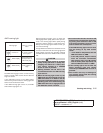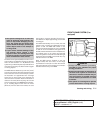
● The system is designed as an aid to the
driver in detecting large stationary ob-
jects to help avoid damaging the ve-
hicle. The system will not detect small
objects below the bumper, and may not
detect objects close to the bumper or
on the ground.
● If your vehicle sustains damage to the
front bumper fascia, leaving it mis-
aligned or bent, the sensing zone may
be altered causing inaccurate measure-
ment of obstacles or false alarms.
The Front Sonar System (FSS) sounds a tone to
warn the driver of obstacles near the front
bumper when the shift selector is in a forward
gear. The system may not detect objects at
speeds above 3mph (5 km/h) andmay not detect
certain angular or moving objects.
The FSS detects obstacles up to 6 feet (1.8 m)
from the front bumper with adecreased coverage
area at the outer corners of the bumper, (refer to
the illustration for approximate zone coverage
areas). As you move closer to the obstacle, the
rate of the tone increases. When the obstacle is
less than 10 inches (25.0 cm) away, the tone will
sound continuously. If the FSS detects a station-
ary or receding object further than 10 inches
(25.0 cm) from the side of the vehicle, the tone
will sound for only three seconds. Once the sys-
tem detects an object approaching, the tone will
sound again.
The FSS automatically turns on when the shift
selector lever is placed in a forward gear and the
ignition is ON. The FSS OFF switchon the instru-
ment panel allows the driver to turn the FSS on
and off. To turn the FSS off, the ignition must be
ON, and the shift selector lever in D (Drive). An
indicator light on the switch will illuminate when
the system is turned off. If the indicator light
illuminates when the FSS is not turned off, it may
indicate a failure in the FSS.
Keep the FSS sensors (located on the front
bumper fascia) free from snow, ice and large
accumulations of dirt (do not clean the sensors
with sharp objects). If the sensors are covered, it
will affect the accuracy of the FSS.
FREEING A FROZEN DOOR LOCK
To prevent a door lock from freezing, apply de-
icer through the key hole. If the lock becomes
frozen, heat the key before inserting it into the key
hole or use the remote keyless entry keyfob (if so
equipped).
ANTI-FREEZE
In the winter when it is anticipated that the tem-
perature will drop below 32°F (0°C), check the
anti-freeze to assure proper winter protection.
For details, see “Engine cooling system” in the
“Maintenance and do-it-yourself” section of this
manual.
BATTERY
If the battery is not fully charged during extremely
cold weather conditions, the battery fluid may
freeze and damage the battery. To maintain maxi-
mum efficiency, the battery should be checked
regularly. For details, see “Battery” in the “Main-
tenance and do-it-yourself” section of this
manual.
COLD WEATHER DRIVING
5-32 Starting and driving
੬ REVIEW COPY—
2008 Armada (wzw)
Owners Manual—USA_English (nna)
03/05/07—arosenma
੭


















